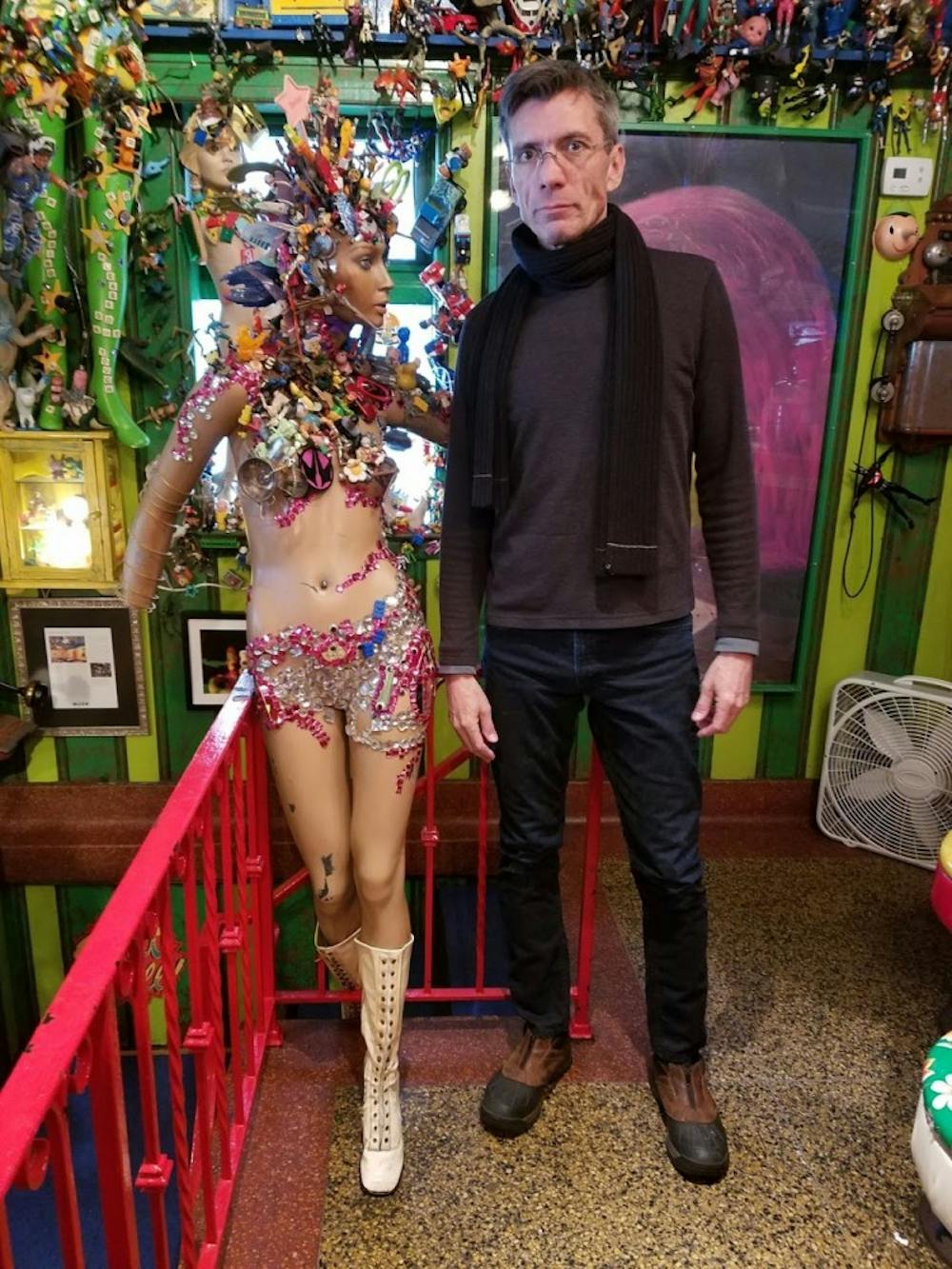“Just a cool place to come in, have some great food, look around and see some cool stuff.”
If you had to describe the Papermoon Diner in a sentence, this would be a pretty good summary. It’s how David Briskie, the diner’s designer, described the inspiration behind putting the place together. The description has been accurate since the diner opened its doors in 1994.
The Remington establishment is easily visible from a distance. The colored walls are starkly different from nearby buildings. Bright mannequins, covered in toys and metal, pose outside.
The inside of Papermoon is just as unique as its exterior. Briskie, who studied sculpture at the Maryland Institute College of Art (MICA), has spent the last 25 years covering the walls with antiques and objects of all kinds. Though many of the decorations can be classified as toys, Briskie points out that not all are. “It’s not just toys. It’s old things,” he said in an interview with The News-Letter.
The building has long been a diner, but it wasn’t always the iconic explosion of art that it is today. Un Kim, Papermoon’s owner, purchased the building in 1994. It was just ending its tenure as a diner known as Open House. It had no dolls or figurines along the walls. It didn’t even have the dining room along West 29th Street.
“It was very different,” Briskie said.
The bar and the dining room along Crestmont Avenue were the only parts of the building that existed. While the dining room had typical seating, the bar was covered in sofas and chairs. It took nearly 10 years before the second dining room was added and the sofas removed.
Though the size of the diner has grown with time, the idea of giving Papermoon a unique vibe was present from the beginning. Kim and Briskie were good friends since his MICA days, when he worked in her sandwich shop. She hired him to redesign the diner. “She wanted a place that would be fun and very eclectic and very colorful, where people could hang out,” Briskie explained.
The original building, built in 1910, was the opposite of Kim’s vision. “It was very typical, the walls were all brown, dark wood, drop ceiling.” The back dining room’s tables were made of orange plastic, a McDonald’s-style seating, as Briskie put it. “Everything left, and the colors came first.”
As for the iconic decor, Briskie simply explained, “It was just a matter of layering stuff.” He knows nearly every piece that adorns the diner’s walls. “I’ve been doing this as long as we’ve been open, so I kind of notice when something’s missing.”
Patrons have taken many items from Papermoon over the years. Briskie had to learn to cope with the fact that some customers pick at and remove his pieces. The downstairs bathrooms have posed the biggest challenge in terms of vandals. Customers picked at them so much that he no longer decorates downstairs beyond painting.
Some robberies, he said, were somewhat amusing. Fraternities and sororities would sometimes steal the outdoor mannequins as part of their rush events. Once, an even stranger act of vandalism occurred: “One year someone stole all the toilets.”
Briskie noted that most of the stealing happened in the past, when the neighborhood was rougher. But he still asks that customers be aware of the purpose behind the diner’s art — treat the decorations as eye candy.
The sheer number of toys and antiques in Papermoon is impressive to behold. Briskie and Kim began decorating when the diner opened. Both collect figurines, which Briskie calls “little people.” They started with their own collections and turned to Baltimore’s antique and junk stores to find more objects to use. “There were a lot of dealers that would drive around and actually stop here with trucks of stuff for me to look at,” Briskie said. Fell’s Point in particular once had a treasure trove of antique stores but no longer.
Fortunately, Papermoon quickly acquired fans. Customers would bring donations over, which they could then see displayed on the walls. Briskie now has a warehouse of items and no longer needs the donations.
Some of Papemoon’s art came from unlikely sources. Some of the 3,000 PEZ dispensers came straight from the company itself. The daughter of PEZ’s president went to Hopkins, and she brought him to the diner. He sent a whole case of dispensers over.
Among the other unique displays are a new Ruth Bader Ginsburg figure, Briskie’s mother’s doll’s sewing machine from around 1910 and grapevines. The vines came from the early days, when Papermoon was first decorated. They were an easy addition because they were free: “We just went out to the woods and cut it down.”
Though it has always been eclectic, Briskie noted that some Baltimoreans felt the diner was too edgy. During its first years, the mannequins especially came under attack. “There was an uproar because they were naked,” he said. Briskie began covering the figures with toys as a solution. He said that some customers are put off by the dolls, but he intentionally tries to keep the diner kid-friendly. Doll heads shouldn’t seem frightening. “Some people get freaked out about them, but I just never understood that,” he said.
Papermoon is an ever-expanding effort. Briskie’s most recent redesign was the handicap bathroom, which he filled with 2,000 cars on the ceiling and 1,000 PEZ dispensers. His next endeavor will be to update the vestibule. “But I haven’t decided what I’m doing yet. That’s the next project,” he said.
It is difficult to update the diner, as it is constantly busy. Papermoon is only closed on Tuesdays. But Briskie is happy that the diner has such a wide fanbase, from students to families.
“I just wanted to create something where anyone that came in could find something that they could relate to.”





